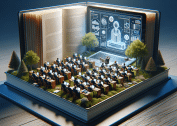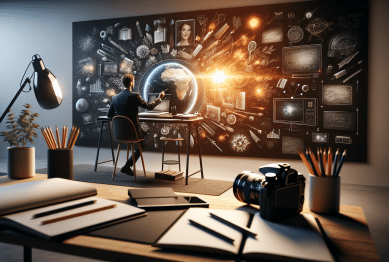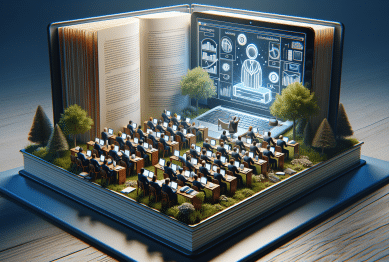Explore how lifelong learning quietly impacts your daily life and future possibilities. This practical guide uncovers surprising advantages, shares real pathways to upskilling, and demystifies how personal development shapes both workplace success and satisfaction with everyday society.
Unpacking Lifelong Learning in Everyday Life
Lifelong learning is more than just returning to a classroom or signing up for a course online. The idea weaves itself through your routine, habits, and even the smallest of ambitions. When you explore new hobbies, adjust to changing technologies, or simply read about current events, you practice lifelong learning without realizing it. This practice is increasingly seen as crucial—both for thriving in a rapidly changing economy and maintaining personal fulfillment. Interestingly, organizations and educational platforms are now tailoring resources to help anyone, anywhere, keep developing relevant skills and knowledge. By connecting you to accessible programs—some through established institutions—you gain the flexibility to adjust learning to personal needs and social developments.
People often misunderstand lifelong learning, thinking it only covers formal education or career training. However, it’s far broader: self-directed study, on-the-job experience, community workshops, and informal peer learning all play significant roles. The skills developed can range from digital literacy to financial management or creative arts. With today’s digital landscape, open-access courses and social learning communities help level the playing field, offering access to quality learning for almost any interest or profession. This approach supports wider educational equity and economic mobility, which many communities seek.
The advantages of constant skill development go beyond simple career improvement. Adaptability, enhanced critical thinking, and greater self-confidence are natural byproducts. Lifelong learning encourages curiosity, helping people see challenges as opportunities for growth. Even companies and policy leaders are recognizing lifelong learning’s transformative effect on both individual lives and broader society. With avenues such as digital platforms, government programs, and employer-sponsored upskilling, anyone interested can find practical ways to keep growing—no matter their background or goals.
The Surprising Social Impact of Personal Upskilling
The ripple effect of personal development extends into entire communities. When individuals regularly upskill, neighborhoods often become more innovative and resilient. Social ties strengthen as people share knowledge or collaborate on civic projects. Programs aimed at digital inclusion, for example, help bridge the technology gap among diverse groups, promoting digital literacy and enabling meaningful participation in modern society. These efforts help fight inequality by making it easier for all ages and backgrounds to adapt, regardless of previous educational experience.
Workforce adaptability is a direct benefit of community-wide lifelong learning. Employers increasingly consider ongoing development as an asset. When teams are versatile—thanks to regular upskilling—they’re better able to respond to shifting market demands or technology changes. Governments and workforce agencies now sponsor programs that encourage career advancement for underrepresented populations, offering both online and offline resources for expanded access. Such initiatives ensure a larger pool of skilled individuals ready to take on roles that may not even exist yet.
Empowerment and social capital grow as more people participate in learning throughout their lives. Community members begin to network in new ways, discussing topics from climate change and civic participation to digital safety. This collaborative learning spirit drives local innovation and helps develop leaders who emerge not just from academic programs but also from real-world experiences. The effect is a more connected and prepared society, resilient to challenges and eager for growth.
Modern Approaches to Adult Education and Skill Building
Adult education has transformed with the rise of digital technology. Open online courses, microcredential platforms, and modular certificate programs provide flexible paths to personal advancement. Many providers design curricula based on real labor market needs; for instance, skills in data analysis, project management, and digital communication are increasingly prioritized. This shift makes it easier for people balancing work and family to revisit education at their own pace. Universities, nonprofits, and tech companies collaborate on programs that mix practical knowledge and academic rigor, often at accessible prices or for free.
Besides formal platforms, businesses also invest in their workforce’s development through mentorship, leadership courses, and in-house technical workshops. Some workplaces create a ‘learning culture’—valuing curiosity as much as productivity. Employees who access diverse learning opportunities feel more motivated and adaptable to changing job descriptions. Such environments benefit employers, too, by nurturing talent from within and supporting innovation. For many, upskilling at work now means blending digital fluency with problem solving, communication, and creativity—traits that are not easily automated.
Learners drive their own pace using self-guided tutorials, podcasts, and collaborative social platforms. Peer-to-peer learning, professional networks, and open-access libraries all ease entry into new domains. As lifelong learning shifts from a formal requirement to an everyday practice, people become more proactive about upskilling—even outside of work. Examples include retirees learning new languages, parents mastering digital parenting, or community members organizing tech literacy campaigns. The modern approach is flexible, diverse, and driven by real-world interests.
Understanding Barriers and Enablers for Lifelong Learners
Despite its value, not everyone finds it easy to access continuing education. Barriers such as time constraints, financial limitations, limited internet access, and low initial confidence often stand in the way. Many studies show that practical support—like childcare provision, flexible scheduling, and community outreach—can make a tangible difference. Efforts to close the digital divide are especially impactful for marginalized groups. Grants, scholarships, and subsidized devices are now offered by both governments and NGOs to help more people pursue skill development according to their needs.
Culture also influences participation. People who grow up in environments valuing curiosity, collaboration, and learning feel more comfortable seeking new knowledge later in life. Organizational cultures that encourage employee growth often provide tailored training or coaching. Even public libraries and community centers step in, bridging gaps by offering informative workshops in safe, welcoming spaces. Media campaigns and positive role models can shift broader societal norms, presenting lifelong learning as an achievable and worthwhile goal for everyone—regardless of background.
Personal motivation is the final piece of the puzzle. Learners cite a mix of curiosity, career goals, and social necessity. Supportive friends, online groups, and positive reinforcement encourage individuals to persevere, even if juggling multiple responsibilities. When educational content connects with real passions or urgent questions, learners persist through setbacks. This cycle reinforces the idea that everyone benefits from an ecosystem focused on enabling—not just providing—ongoing education.
Future Trends Making Lifelong Learning Easier for You
Emerging technologies are reshaping what lifelong learning looks like. Artificial intelligence powers adaptive platforms that offer personalized recommendations based on your interests and skill level. Virtual reality allows immersive experiences, such as language simulations or technical practice in a risk-free setting. These innovations help tailor content, making it easier for more people to jump in at their own level and progress at their own speed.
Microlearning—short, focused modules—fits learning into busy schedules. Mobile devices encourage on-the-go lessons, whether for brushing up on leadership skills before a meeting or learning health tips in daily routines. Such flexibility supports parents, caregivers, and shift workers alike. Expect to see more recognition for informal learning through open badges and digital portfolios, which showcase mastery of skills earned outside the traditional classroom.
Institutions, employers, and policy makers are investing in lifelong learning infrastructure, aiming to bridge systemic gaps. Partnerships between public and private sectors ensure quality and relevance—aligning education with evolving labor markets. You may soon find even more accessible pathways to reskill or explore new interests, from micro-credentials accepted by employers to intergenerational learning communities in your neighborhood. The promise of lifelong learning lies in its adaptability—empowering you to stay curious, relevant, and prepared for whatever’s ahead.
Measuring Success and Making Lifelong Learning Practical
Success in lifelong learning isn’t just about certificates or job titles—it’s about meaningful growth. Individuals who regularly challenge themselves demonstrate stronger problem-solving abilities, improved emotional intelligence, and greater adaptability. Longitudinal research connects lifelong learners with higher career satisfaction and better economic resilience. Tracking your own small wins, such as learning a new app or mastering a community project, helps sustain a lifelong learning mindset. Reflection and feedback from mentors can further drive progress.
Practical tools for making learning stick include digital journals, accountability partners, and dedicated ‘learning time’ in your weekly schedule. Modern platforms may use gamified elements and reminders to encourage consistency. Self-assessment tools—like quizzes or milestone trackers—support sustained engagement. Importantly, success is unique to each person, reflecting goals that might be deeply personal or widely shared across a workplace or community.
Integrating lifelong learning into everyday life means celebrating progress, not just outcomes. Sharing new knowledge, teaching others, or participating in community initiatives spreads the benefits further. By viewing skill development as a continuous part of daily living, everyone can unlock hidden value—opening doors, strengthening resilience, and preparing to embrace opportunities yet to appear.
References
1. Organisation for Economic Co-operation and Development. (n.d.). The case for lifelong learning. Retrieved from https://www.oecd.org/education/the-case-for-lifelong-learning.htm
2. World Economic Forum. (n.d.). Lifelong learning: Key to the future of work. Retrieved from https://www.weforum.org/agenda/2022/09/lifelong-learning-future-work
3. UNESCO Institute for Lifelong Learning. (n.d.). What is lifelong learning? Retrieved from https://uil.unesco.org/lifelong-learning/what-is-lifelong-learning
4. National Center for Education Statistics. (n.d.). Adult learning in focus. Retrieved from https://nces.ed.gov/pubs2022/2022139.pdf
5. U.S. Department of Education. (n.d.). Supporting lifelong learning. Retrieved from https://www.ed.gov/news/speeches/supporting-lifelong-learning
6. MIT Open Learning. (n.d.). The impact of microcredentials and digital learning. Retrieved from https://openlearning.mit.edu/about/news/impact-microcredentials-and-digital-learning









